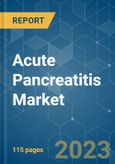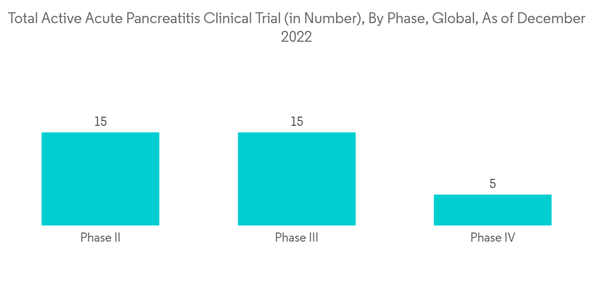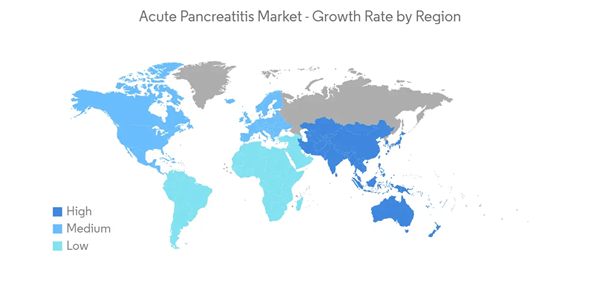The acute pancreatitis market studied is expected to register an estimated CAGR of 5.07% over the forecast period.
COVID impacted the growth of the acute pancreatitis market owing to the suspension of diagnosis and treatment services as well as the shutdown of hospitals due to the lockdown measures imposed by the government. For instance, according to an article published in the International Journal of Molecular Science in January 2022, it was observed that some SARS-CoV-2 inpatients developed acute pancreatitis as a result of the virus directly infecting the tissue or from systemic multiple organ dysfunction syndromes (MODS), which was accompanied by increased amylase and lipase levels. Additionally, a literature review published in Frontiers in Medicine in January 2022 showed that 7% of patients with severe COVID-19 had imaging signs consistent with pancreatitis, whereas 17% of them had pancreatic damage with high serum lipase and amylase levels. Thus, the high risk of pancreatitis among COVID-19 patients impacted the demand for acute pancreatitis treatment during the forecast period. However, with the resumed services and increased hospital visits, the market is expected to grow over the forecast period.
Factors such as the increasing incidence of gallstones and obesity and ongoing research and development activities for the diseases are boosting market growth.
The rising burden of gallstones and obesity among the population raises the risk of developing acute pancreatitis, which in turn is expected to increase the demand for effective drugs and devices to reduce pain and treat the condition, hence propelling market growth. For instance, according to an article published in the NLM in September 2021, it has been observed that the incidence of acute pancreatitis is increasing over time, especially in western countries. As per an article published in the Gastrointestinal Journal, in April 2022, the annual incidence of acute pancreatitis will range from 4.9 to 35 per 100,000 people in the United States.
Additionally, smoking, high alcohol consumption, and obesity in the population are found to be the most prevalent risk factors for gallstones and acute pancreatitis, respectively. This is anticipated to increase market growth over the forecast period. For instance, as per the 2022 statistics published by the World Population, Naru (61%) has the highest number of obese populations, followed by Palau (55.30%), the United States (36.20%), and Egypt (32%). As per the same source, Vietnam (2.10%) has the lowest number of obese people. The high number of obese populations raises the level of hypertriglyceridemia in the body as well as increases gallstones. This is anticipated to increase the risk of developing acute pancreatitis, hence bolstering market growth.
Furthermore, as per an article published in the NLM in May 2022, it has been observed that chronic alcohol use is the second most common cause of acute pancreatitis (AP) after gallstones, accounting for 17% to 25% of cases of the condition globally. Also, as per the data published by the Australian Bureau of Statistics, in March 2022, one in four Australians aged 18 and older exceeded the Australian Adult Alcohol Guideline in 2020-21 (25.8%). Thus, the increasing prevalence of alcohol consumption is expected to increase market growth by increasing the prevalence of acute pancreatitis.
Moreover, the rising research and development activities of the companies are also contributing to market growth. For instance, in April 2021, Lamassu Pharma developed a new treatment, RABI-767, a novel small molecule lipase inhibitor, to treat acute pancreatitis.
Therefore, owing to the aforementioned factors, the studied market is expected to grow over the forecast period. However, the poor reimbursement policies and high cost of treatment, as well as the stringent regulatory requirements for drug and device approvals, are expected to impede the growth of the acute pancreatitis market over the forecast period.
Acute pancreatitis is related to heavy fluid loss and dehydration, which can be fatal and may lead to the death of the patient. Intravenous fluid administration in the body keeps the body hydrated and ensures proper blood flow to the rest of the body's organs.
The prevalence of chronic comorbidities is rising globally, and this has been accompanied by a growing interest in how these comorbidities affect patients with acute pancreatitis. For instance, according to a research study published in BioMed Hub in November 2021, it has been observed that gastrointestinal symptoms are associated with pre-existing metabolic syndrome, obesity, diabetes mellitus, and metabolic syndrome in the early stages of acute pancreatitis. Also, according to the article published in PLOS One in June 2021, obesity is considered a significant public health problem in France as it is a risk factor for chronic diseases such as diabetes and hypertension, etc., which in turn have substantial psychological and social consequences. Thus, the high burden of obesity increases the risk of developing pancreatitis due to their overeating habits, which in turn is anticipated to fuel the segment's growth over the forecast period.
Furthermore, as per an article published in the NLM in June 2022, it has been found that fluid resuscitation primarily serves to maintain organ perfusion (hemodynamics) and substrate supply (oxygen, among other things) by administering fluid and electrolytes. Also, doctors can restore fluid losses by delivering intravenous (IV) injections rather than using the enteral route when oral intake is not practical. Thus, the advantages of IV fluid therapy over others are expected to increase its adoption and, hence, segment growth.
Therefore, owing to factors such as the high burden of obesity and the increasing adoption of IV therapy, the studied segment is expected to grow over the forecast period.
According to an article published by the NLM, in November 2022, acute pancreatitis will be the most prevalent gastrointestinal condition and the main reason for hospitalization in the United States. Also, as per an article published in MedRxiv in July 2022, it has been observed that the prevalence of gallstone disease contributed to approximately 2.2 million ambulatory care visits, 1.1 million emergency department visits, and 615,000 hospital discharges in the United States. In addition, as per the same source, it has been observed that women are more likely to develop gallstones as compared to men.
Furthermore, the increasing research and development activities in the region are anticipated to fuel demand for drug- and device-based therapies for treating acute pancreatitis, thereby fueling market growth. For instance, in December 2022, St. Jude Children's Research Hospital, in collaboration with CalciMedica, Inc., will conduct a Phase I/II clinical study assessing the tolerability and efficacy of CM4620 in children and young adults with acute pancreatitis caused by asparaginase. Also, in April 2022, Boston Children's Hospital, in collaboration with the National Pancreas Foundation, will conduct a Phase II clinical study to assess the efficacy of a first-line analgesic in pediatric patients who present to the emergency department with a diagnosis of acute pancreatitis.
Moreover, the rising company activities in developing effective drugs and devices for the treatment of acute pancreatitis are also contributing to market growth. For instance, in October 2022, Regeneron Pharmaceuticals will conduct a Phase II clinical study evaluating the efficacy and safety of evinacumab in patients with severe hypertriglyceridemia for the prevention of recurrent acute pancreatitis.
Therefore, due to factors such as the high burden of acute pancreatitis and gallstones among the population, growing research and development activities, and rising product launches in the region, the studied market is expected to grow over the forecast period.
This product will be delivered within 2 business days.
COVID impacted the growth of the acute pancreatitis market owing to the suspension of diagnosis and treatment services as well as the shutdown of hospitals due to the lockdown measures imposed by the government. For instance, according to an article published in the International Journal of Molecular Science in January 2022, it was observed that some SARS-CoV-2 inpatients developed acute pancreatitis as a result of the virus directly infecting the tissue or from systemic multiple organ dysfunction syndromes (MODS), which was accompanied by increased amylase and lipase levels. Additionally, a literature review published in Frontiers in Medicine in January 2022 showed that 7% of patients with severe COVID-19 had imaging signs consistent with pancreatitis, whereas 17% of them had pancreatic damage with high serum lipase and amylase levels. Thus, the high risk of pancreatitis among COVID-19 patients impacted the demand for acute pancreatitis treatment during the forecast period. However, with the resumed services and increased hospital visits, the market is expected to grow over the forecast period.
Factors such as the increasing incidence of gallstones and obesity and ongoing research and development activities for the diseases are boosting market growth.
The rising burden of gallstones and obesity among the population raises the risk of developing acute pancreatitis, which in turn is expected to increase the demand for effective drugs and devices to reduce pain and treat the condition, hence propelling market growth. For instance, according to an article published in the NLM in September 2021, it has been observed that the incidence of acute pancreatitis is increasing over time, especially in western countries. As per an article published in the Gastrointestinal Journal, in April 2022, the annual incidence of acute pancreatitis will range from 4.9 to 35 per 100,000 people in the United States.
Additionally, smoking, high alcohol consumption, and obesity in the population are found to be the most prevalent risk factors for gallstones and acute pancreatitis, respectively. This is anticipated to increase market growth over the forecast period. For instance, as per the 2022 statistics published by the World Population, Naru (61%) has the highest number of obese populations, followed by Palau (55.30%), the United States (36.20%), and Egypt (32%). As per the same source, Vietnam (2.10%) has the lowest number of obese people. The high number of obese populations raises the level of hypertriglyceridemia in the body as well as increases gallstones. This is anticipated to increase the risk of developing acute pancreatitis, hence bolstering market growth.
Furthermore, as per an article published in the NLM in May 2022, it has been observed that chronic alcohol use is the second most common cause of acute pancreatitis (AP) after gallstones, accounting for 17% to 25% of cases of the condition globally. Also, as per the data published by the Australian Bureau of Statistics, in March 2022, one in four Australians aged 18 and older exceeded the Australian Adult Alcohol Guideline in 2020-21 (25.8%). Thus, the increasing prevalence of alcohol consumption is expected to increase market growth by increasing the prevalence of acute pancreatitis.
Moreover, the rising research and development activities of the companies are also contributing to market growth. For instance, in April 2021, Lamassu Pharma developed a new treatment, RABI-767, a novel small molecule lipase inhibitor, to treat acute pancreatitis.
Therefore, owing to the aforementioned factors, the studied market is expected to grow over the forecast period. However, the poor reimbursement policies and high cost of treatment, as well as the stringent regulatory requirements for drug and device approvals, are expected to impede the growth of the acute pancreatitis market over the forecast period.
Acute Pancreatitis Market Trends
Intravenous Fluids Segment is Expected to Grow Over the Forecast Period
The intravenous-fluid therapy segment is expected to witness significant growth in the acute pancreatitis market over the forecast period owing to factors such as the rising burden of acute pancreatitis, gallstones, and obesity among the population and their risk-associated factors.Acute pancreatitis is related to heavy fluid loss and dehydration, which can be fatal and may lead to the death of the patient. Intravenous fluid administration in the body keeps the body hydrated and ensures proper blood flow to the rest of the body's organs.
The prevalence of chronic comorbidities is rising globally, and this has been accompanied by a growing interest in how these comorbidities affect patients with acute pancreatitis. For instance, according to a research study published in BioMed Hub in November 2021, it has been observed that gastrointestinal symptoms are associated with pre-existing metabolic syndrome, obesity, diabetes mellitus, and metabolic syndrome in the early stages of acute pancreatitis. Also, according to the article published in PLOS One in June 2021, obesity is considered a significant public health problem in France as it is a risk factor for chronic diseases such as diabetes and hypertension, etc., which in turn have substantial psychological and social consequences. Thus, the high burden of obesity increases the risk of developing pancreatitis due to their overeating habits, which in turn is anticipated to fuel the segment's growth over the forecast period.
Furthermore, as per an article published in the NLM in June 2022, it has been found that fluid resuscitation primarily serves to maintain organ perfusion (hemodynamics) and substrate supply (oxygen, among other things) by administering fluid and electrolytes. Also, doctors can restore fluid losses by delivering intravenous (IV) injections rather than using the enteral route when oral intake is not practical. Thus, the advantages of IV fluid therapy over others are expected to increase its adoption and, hence, segment growth.
Therefore, owing to factors such as the high burden of obesity and the increasing adoption of IV therapy, the studied segment is expected to grow over the forecast period.
North America is Expected to Have the Significant Market Share Over the Forecast Period
North America is expected to witness healthy growth in the acute pancreatitis market over the forecast period. The increasing population of people suffering from acute pancreatitis, the increasing number of obesity and gallstone cases, the increasing number of research studies, the presence of a well-established healthcare infrastructure, and high healthcare spending are all factors contributing to the market's growth.In addition, the rising prevalence of obesity among the population due to their changing lifestyles has increased the risk of developing pancreatic inflammation, which in turn is expected to fuel market growth.According to an article published by the NLM, in November 2022, acute pancreatitis will be the most prevalent gastrointestinal condition and the main reason for hospitalization in the United States. Also, as per an article published in MedRxiv in July 2022, it has been observed that the prevalence of gallstone disease contributed to approximately 2.2 million ambulatory care visits, 1.1 million emergency department visits, and 615,000 hospital discharges in the United States. In addition, as per the same source, it has been observed that women are more likely to develop gallstones as compared to men.
Furthermore, the increasing research and development activities in the region are anticipated to fuel demand for drug- and device-based therapies for treating acute pancreatitis, thereby fueling market growth. For instance, in December 2022, St. Jude Children's Research Hospital, in collaboration with CalciMedica, Inc., will conduct a Phase I/II clinical study assessing the tolerability and efficacy of CM4620 in children and young adults with acute pancreatitis caused by asparaginase. Also, in April 2022, Boston Children's Hospital, in collaboration with the National Pancreas Foundation, will conduct a Phase II clinical study to assess the efficacy of a first-line analgesic in pediatric patients who present to the emergency department with a diagnosis of acute pancreatitis.
Moreover, the rising company activities in developing effective drugs and devices for the treatment of acute pancreatitis are also contributing to market growth. For instance, in October 2022, Regeneron Pharmaceuticals will conduct a Phase II clinical study evaluating the efficacy and safety of evinacumab in patients with severe hypertriglyceridemia for the prevention of recurrent acute pancreatitis.
Therefore, due to factors such as the high burden of acute pancreatitis and gallstones among the population, growing research and development activities, and rising product launches in the region, the studied market is expected to grow over the forecast period.
Acute Pancreatitis Market Competitor Analysis
The acute pancreatitis market is moderately fragmented, with several players across the globe. Due to the limited treatment options available, there is high competition in the market. In terms of market share, a few of the major players currently dominate the market. With the rising patient awareness levels and high prevalence of diseases, many regional players are expected to be part of the acute pancreatitis market over the forecast period. Some of the major players in the market are Abbott Laboratories, Pfizer Inc., Merck & Co., Inc., GlaxoSmithKline, Baxter International Inc., Fresenius SE & Co. KGaA, Dynavax Technologies Corporation, B. Braun SE, and others.Additional benefits of purchasing the report:
- The market estimate (ME) sheet in Excel format
- 3 months of analyst support
This product will be delivered within 2 business days.
Table of Contents
1 INTRODUCTION
4 MARKET DYNAMICS
5 MARKET SEGMENTATION (Market Size by Value - USD million)
6 COMPETITIVE LANDSCAPE
Companies Mentioned (Partial List)
A selection of companies mentioned in this report includes, but is not limited to:
- Abbott Laboratories
- B. Braun SE
- Baxter International Inc.
- CalciMedica Inc.
- Dynavax Technologies Corporation
- Fresenius SE & Co. KGaA
- GlaxoSmithKline
- Merck & Co., Inc
- Olympus Corporation
- Pfizer Inc.
- SCM Lifescience
Methodology

LOADING...










